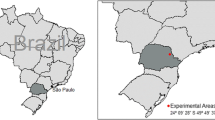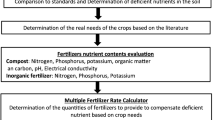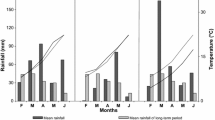Abstract
Purpose
Industrial organic waste (IOW) from slaughter and processing of poultry and swine might be potential crop fertilizer. The use of IOW is known to alter the dynamics of soil organic carbon (SOC) and exchangeable cations. However, its effects on soil physical properties and processes are still unknown. The aim of this study was to evaluate the effects of the isolated and combined application of IOW and mineral fertilizers (MF) on SOC pools, structural physical properties, water retention, and some chemical properties under long-term no-tillage system.
Materials and methods
Treatments applied during 6 years were as follows: control (no fertilizers application) and crop nutrients through MF, IOW, and MF + IOW. We evaluated SOC pools (total, permanganate (POx-C), and hot water extractable (HWE-C)), structural soil physical properties (i.e., porosity and water retention), and exchangeable cation contents at 0–10 and 10–20 cm layers.
Results and discussion
The HWE-C increased in response to IOW application in relation to the control treatment at the 0–10 cm layer. POx-C with MF was closer to IOW application. However, this SOC pool was more affected at 10–20 cm layer, in which the IOW and MF promoted increases of POx-C in relation to control. Both forms of fertilization increased total porosity and water retention and the highest values were observed for IOW. We observed a high correlation between the increases of labile SOC and the improvement of soil physical conditions. The long-term exclusive MF application induced damages on soil, such as decreases in water retention and availability of nutrients. The results of MF + IOW were closer to those of MF treatment than IOW treatment.
Conclusions
The IOW evaluated is a suitable fertilization strategy, providing soil quality. But their use must be carried out in isolation or in combinations with mineral fertilizers greater than 50% of the blend. Also, this IOW is harmless to health and hygiene due to its treatment.



Similar content being viewed by others
References
Alvarenga P, Mourinha C, Farto M, Santos T, Palma P, Sengo J, Morais MC, Cunha-Queda C (2015) Sewage sludge, compost and other representative organic wastes as agricultural soil amendments: benefits versus limiting factors. Waste Manag 40:44–52. https://doi.org/10.1016/j.wasman.2015.01.027
Alvares CA, Stape JL, Sentelhas PC, Gonçalves JLM, Sparovek G (2013) Köppen’s climate classification map for Brazil. Meteorol Z 22:711–728. https://doi.org/10.1127/0941-2948/2013/0507
Anacleto LR, Roberto MM, Marin-Morales MA (2017) Toxicological effects of the waste of the sugarcane industry, used as agricultural fertilizer, on the test system Allium cepa. Chemosphere 173:31–42. https://doi.org/10.1016/j.chemosphere.2017.01.033
Antille DL, McCabe BK, Van Der Spek W, Baillie CP (2018) An investigation into the fertilizer potential of slaughterhouse cattle paunch. Trans ASABE 61:87–101. https://doi.org/10.13031/trans.12342
Antille DL, O’Sullivan KC, McCabe BK, Marchuk S, Eberhard J, Lee S, Baillie CP (2019) Long-term land application of slaughterhouse cattle paunch effects on soil properties. In 2019 ASABE Annual International Meeting. American Society of Agricultural and Biological Engineers https://doi.org/10.13031/aim.201900047
Athmann M, Kautz T, Huang N, Köpke U (2014) Biopore characterization with in situ endoscopy: influence of earthworms on carbon and nitrogen contents. In: Rahmann G, Aksoy U (eds) Proceedings of the 4th ISOFAR Scientific Conference. Organic World Congress, Turkey, pp 415–418
Auler AC, Pires LF, Caires EF (2017a) Surface and incorporated liming effects on clay dispersion, water availability, and aeration capacity of a Dystrudept soil. Bragantia 76:433–446. https://doi.org/10.1590/1678-4499.290
Auler AC, Pires LF, Santos JAB, Caires EF, Borges JAR, Giarola NFB (2017b) Effects of surface-applied and soil-incorporated lime on some physical attributes of a Dystrudept soil. Soil Use Manag 33:129–140. https://doi.org/10.1111/sum.12330
Ayuke FO, Brussaard L, Vanlauwe B, Six J, Lelei DK, Kibunja CN, Pulleman MM (2011) Soil fertility management: impacts on soil macrofauna, soil aggregation and soil organic matter allocation. Appl Soil Ecol 4:53–62. https://doi.org/10.1016/j.apsoil.2011.02.001
Barreto RC, Madari BE, Maddock JE, Machado PL, Torres E, Franchini J, Costa AR (2009) The impact of soil management on aggregation, carbon stabilization and carbon loss as CO2 in the surface layer of a Rhodic Ferralsol in Southern Brazil. Agric Ecosyst Environ 132:243–251. https://doi.org/10.1016/j.agee.2009.04.008
Bertrand M, Barot S, Blouin M, Whalen J, Oliveira T, Roger-Estrade J (2015) Earthworm services for cropping systems. A review. Agron Sustain Dev 35:553–567. https://doi.org/10.1007/s13593-014-0269-7
Briedis C, Sá JCM, Caires EF, Navarro JF, Inagaki TM, Boer A, Quadros Neto C, Ferreira AO, Canalli LB, Santos JB (2012) Soil organic matter pools and carbon protection mechanisms in aggregate classes influenced by surface liming in a no-till system. Geoderma 170:80–88. https://doi.org/10.1016/j.geoderma.2011.10.011
Bronick CJ, Lal R (2005) Soil structure and management: a review. Geoderma 124:3–22. https://doi.org/10.1016/j.geoderma.2004.03.005
Bu X, Wang L, Ma W, Yu X, McDowell WH, Ruan H (2010) Spectroscopic characterization of hot-water extractable organic matter from soils under four different vegetation types along an elevation gradient in the Wuyi Mountains. Geoderma 159:139–146. https://doi.org/10.1016/j.geoderma.2010.07.005
Carvalho MAC, Panosso AR, Teixeira EER, Araújo EG, Brancaglioni VA, Dallacort R (2018) Multivariate approach of soil attributes on the characterization of land use in the southern Brazilian Amazon. Soil Tillage Res 184:207–215. https://doi.org/10.1016/j.still.2018.08.004
Castro Filho C, Muzilli O, Podanoschi AL (1998) Estabilidade dos agregados e sua relação com o teor de carbono orgânico num Latossolo roxo distrófico, em função de sistemas de plantio, rotações de culturas e métodos de preparo das amostras. R Bras Ci Solo 22:527–538. https://doi.org/10.1590/S0100-06831998000300019
Cercioglu M, Anderson SH, Udawatta RP, Haruna SI (2018) Effects of cover crop and biofuel crop management on computed tomography-measured pore parameters. Geoderma 319:80–88. https://doi.org/10.1016/j.geoderma.2018.01.005
Cherubin MR, Eitelwein MT, Fabbris C, Weirich SW, Silva RF, Silva VR, Basso CJ (2015) Qualidade física, química e biológica de um Latossolo com diferentes manejos e fertilizantes. R Bras Ci Solo 39:615–625. https://doi.org/10.1590/01000683rbcs20140462
Colombi T, Braun S, Keller T, Walter A (2017) Artificial macropores attract crop roots and enhance plant productivity on compacted soils. Sci Total Environ 574:1283–1293. https://doi.org/10.1016/j.scitotenv.2016.07.194
Dane JH, Topp CG, Campbell GS (2002) Methods of soil analysis: part 4–physical methods. Soil Science Society of America, Madison
Drechsel P, Heffer P, Magen H, Mikkelsen P, Wichelns D (2015) Managing water and fertilizer for sustainable agricultural intensification. International Fertilizer Industry Association, International Water Management Institute, International Plant Nutrition Institute and International Potash Institute, Paris
Dunjana N, Nyamugafata P, Shumba A, Nyamangara J, Zingore S (2012) Effects of cattle manure on selected soil physical properties of smallholder farms on two soils of Murewa, Zimbabwe. Soil Use Manag 28:221–228. https://doi.org/10.1111/j.1475-2743.2012.00394.x
Edwards AP, Bremner JM (1967) Microaggregates in soils. J Soil Sci 18:64–73. https://doi.org/10.1111/j.1365-2389.1967.tb01488.x
Evanylo G, Sherony C, Spargo J, Starner D, Brosius M, Haering K (2008) Soil and water environmental effects of fertilizer-, manure-, and compost-based fertility practices in an organic vegetable cropping system. Agric Ecosyst Environ 127:50–58. https://doi.org/10.1016/j.agee.2008.02.014
FAO (2019) Basic principles of conservation agriculture. http://www.fao.org/ag/ca/1ahtml. Acessed 10 June 2019
FAO, IIASA, ISRIC, ISSCAS, JRC (2009) harmonized world soil database (version 1.1), FAO and IIASA, Rome, Italy, and Laxenburg, Austria
Ferreira TR, Pires LF, Wildenschild D, Brinatti AM, Borges JA, Auler AC, Reis AM (2019) Lime application effects on soil aggregate properties: use of the mean weight diameter and synchrotron-based X-ray μCT techniques. Geoderma 338:585–596. https://doi.org/10.1016/j.geoderma.2018.10.035
Ghani A, Dexter M, Perrott KW (2003) How water extractable carbon in soil: a sensitive measurement for determining impacts of fertilization, grazing and cultivation. Soil Biol Biochem 35:1231–1243. https://doi.org/10.1016/S0038-0717(03)00186-X
Girotto F, Alibardi L, Cossu R (2015) Food waste generation and industrial uses: a review. Waste Manag 45:32–41. https://doi.org/10.1016/j.wasman.2015.06.008
Gómez-Brandón M, Domínguez J (2014) Recycling of solid organic wastes through vermicomposting: microbial community changes throughout the process and use of vermicompost as a soil amendment. Crit Rev Environ Sci Technol 44:1289–1312. https://doi.org/10.1080/10643389.2013.763588
Han J, Shi J, Zeng L, Xu J, Wu L (2017) Impacts of continuous excessive fertilization on soil potential nitrification activity and nitrifying microbial community dynamics in greenhouse system. J Soils Sediments 17:471–480. https://doi.org/10.1007/s11368-016-1525-z
Haynes RJ, Naidu R (1998) Influence of lime, fertilizer and manure applications on soil organic matter content and soil physical conditions: a review. Nutr Cycl Agroecosys 51:123–137. https://doi.org/10.1023/A:1009738307837
Illera-Vives M, Labandeira SS, Loureiro LI, López-Mosquera ME (2017) Agronomic assessment of a compost consisting of seaweed and fish waste as an organic fertilizer for organic potato crops. J Appl Phycol 29:1663–1671. https://doi.org/10.1007/s10811-017-1053-2
Inagaki TM, Sa JCM, Caires EF, Goncalves DRP (2016) Lime and gypsum application increases biological activity, carbon pools, and agronomic productivity in highly weathered soil. Agric Ecosyst Environ 231:156–165. https://doi.org/10.1016/j.agee.2016.06.034
Ju X, Kou C, Christie P, Dou Z, Zhang F (2007) Changes in the soil environment from excessive application of fertilizers and manures to two contrasting intensive cropping systems on the North China Plain. Environ Pollut 145:497–506. https://doi.org/10.1016/j.envpol.2006.04.017
Lavelle P, Decaëns T, Aubert M, Barot S, Blouin M, Bureau F, Margerie P, Mora P, Rossi JP (2006) Soil invertebrates and ecosystem services. Eur J Soil Biol 42:3–15. https://doi.org/10.1016/j.ejsobi.2006.10.002
Liang Q, Chen H, Gong Y, Fan M, Yang H, Lal R, Kuzyakov Y (2012) Effects of 15 years of manure and inorganic fertilizers on soil organic carbon fractions in a wheat-maize system in the North China Plain. Nutr Cycl Agroecosyst 92:21–33. https://doi.org/10.1007/s10705-011-9469-6
Marchuk A, Rengasamy P (2011) Clay behaviour in suspension is related to the ionicity of clay–cation bonds. Appl Clay Sci 53:754–759. https://doi.org/10.1016/j.clay.2011.05.019
Mualem Y (1976) Hydraulic conductivity of unsaturated soils: prediction and formulas. In: Klute A (ed) Methods of soil analysis: I. Physical and mineralogical methods. Soil Science Society of America, Madison, pp 799–823
Nayak AK, Gangwar B, Shukla AK, Mazumdar SP, Kumar A, Raja R, Kumar A, Kumar V, Rai PK, Mohan U (2012) Long-term effect of different integrated nutrient management on soil organic carbon and its fractions and sustainability of rice–wheat system in Indo Gangetic Plains of India. Field Crops Res 127:129–139. https://doi.org/10.1016/j.fcr.2011.11.011
Oliveira D, Lima RP, Verburg J, Ernst E (2015) Qualidade física do solo sob diferentes sistemas de manejo e aplicação de dejeto líquido suíno. Agriambi 19:280–285. https://doi.org/10.1590/1807-1929/agriambi.v19n3p280-285
Pagenkemper SK, Athmann M, Uteau D, Kautz T, Peth S, Horn R (2015) The effect of earthworm activity on soil bioporosity–investigated with X-ray computed tomography and endoscopy. Soil Till Res 146:79–88. https://doi.org/10.1016/j.still.2014.05.007
Pauletti V, Motta ACV (2019) Manual de adubação e calagem para o estado do Paraná. 2. Ed. Núcleo Estadual Paraná da Sociedade Brasileira de Ciência do Solo, Curitiba
Pierzynski GM (1991) The chemistry and mineralogy of phosphorus in excessively fertilized soils. Crit Rev Environ Sci Technol 21:265–295. https://doi.org/10.1080/10643389109388418
R Core Team (2018) R: a language and environment for statistical computing. R Foundation for Statistical Computing, Vienna
Regelink IC, Stoof CR, Rousseva S, Weng L, Lair GJ, Kram P, Nikolaidis NP, Kercheva M, Banwart S, Comans RNJ (2015) Linkages between aggregate formation, porosity and soil chemical properties. Geoderma 247:24–37. https://doi.org/10.1016/j.geoderma.2015.01.022
Rengasamy P, Marchuk A (2011) Cation ratio of soil structural stability (CROSS). Soil Res 49:280–285. https://doi.org/10.1071/SR10105
Romaniw J (2018). Resíduos de abatedouro na dinâmica da matéria orgânica, retenção de água no solo, produtividade das culturas e eficiência em sistema de plantio direto. Thesis, State University of Ponta Grossa. (Abstract in English)
Romaniw J, Sá JCM, Padilha AP, Ramos FA, Eurich G, Bressan PT (2015) Carbon dynamics in no-till soil due to the use of industrial organic waste and mineral fertilizer. R Ci Agron 46:477–487. https://doi.org/10.5935/1806-6690.20150029
Sá JCM, Cerri CC, Lal R, Dick WA, Piccolo MC, Feigl BE (2009) Soil organic carbon and fertility interactions affected by a tillage chronosequence in a Brazilian Oxisol. Soil Till Res 104:56–64. https://doi.org/10.1016/j.still.2008.11.007
Sá JCM, Séguy L, Tivet F, Lal R, Bouzinac S, Borszowskei PR, Briedis C, Santos JB, Hartman DC, Bertoloni CG, Rosa JA, Friedrich T (2015) Carbon depletion by plowing and its restoration by no-till cropping systems in Oxisols of subtropical and tropical agro-ecoregions in Brazil. Land Degrad Develop 26:531–543. https://doi.org/10.1002/ldr.2218
Santos HG, Jacomine PKT, Anjos LHC, Oliveira VA, Lumbreras JF, Coelho MR, Almeida JA, Cunha TJF, Oliveira JB (2018) Sistema brasileiro de classificação de solos. Embrapa Solos, Rio de Janeiro
Seki K (2007) SWRC fit-a nonlinear fitting program with a water retention curve for soils having unimodal and bimodal pore structure. Hydrol Earth Sys Sci Discuss 4:407–437. https://doi.org/10.5194/hessd-4-407-2007
Silva RR, Leite RC, Carneiro JSS, Freitas GA, Santos ACM, Santos AC, Kuyumjian LA (2019) Application of slaughterhouse residues as nitrogen source replacing commercial fertilizers on mombasa grass (Megathyrsus maximus). Aust J Crop Sci 13:294–299. https://doi.org/10.21475/ajcs.19.13.02.p1459
Sparks DL (2003) Environmental soil chemistry. Elsevier Science, San Diego
Sposito G (2008) The chemistry of soils. Oxford University, New York
Steiner C, Teixeira WG, Lehmann J, Nehls T, Macêdo JLV, Blum WEH, Zech W (2007) Long term effects of manure, charcoal and mineral fertilization on crop production and fertility on a highly weathered Central Amazonian upland soil. Plant Soil 291:275–290. https://doi.org/10.1007/s11104-007-9193-9
Thomas BW, Luo Y, Li C, Hao X (2017) Utilizing composted beef cattle manure and slaughterhouse waste as nitrogen and phosphorus fertilizers for calcareous soil. Compost Sci Util 25:102–111. https://doi.org/10.1080/1065657X.2016.1219681
Tirol-Padre A, Ladha JK (2004) Assessing the reliability of permanganate-oxidizable carbon as an index of soil labile carbon. Soil Sci Soc Am J 68:969–978. https://doi.org/10.2136/sssaj2004.0969
Tisdall JM, Oades JM (1982) Organic matter and water-stable aggregates in soils. J Soil Sci 33:141–163. https://doi.org/10.1111/j.1365-2389.1982.tb01755.x
Tivet F, Sá JCM, Lal R, Briedis C, Borszowskei PR, Santos JB, Farias A, Eurich G, Hartman DC, Nadolny Junior M, Bouzinac S, Séguy L (2013) Aggregate C depletion by plowing and its restoration by diverse biomass-C inputs under no-till in sub-tropical and tropical regions of Brazil. Soil Till Res 126:203–218. https://doi.org/10.1016/j.still.2012.09.004
van Genuchten MT (1980) A closed-form equation for predicting the hydraulic conductivity of unsaturated soils. Soil Sci Soc Am J 44:892–898. https://doi.org/10.2136/sssaj1980.03615995004400050002x
van Raij B, Andrade JC, Cantarella H, Quaggio JA (2001) Análise química para avaliação da fertilidade de solos tropicais. Instituto Agronômico de Campinas, Campinas
Yoder RE (1936) A direct method of aggregate analysis of soils and study of the physical nature of erosion losses. Agron J 28:337–351
Zwetsloot MJ, Lehmann J, Solomon D (2015) Recycling slaughterhouse waste into fertilizer: how do pyrolysis temperature and biomass additions affect phosphorus availability and chemistry? J Sci Food Agric 95:28–288. https://doi.org/10.1002/jsfa.6716
Funding
The authors like to acknowledge the financial support provided by the Brazilian National Council for Scientific and Technological Development (CNPq), for productivity in research scholarships to LF Pires (303726/2015-6) and JCM Sá (482292/2012-1), the Coordination for the Improvement of Higher Education Personnel (Capes), for scholarships (1794317, 1469659 and 1144541) to AC Auler, J Romaniw, DC Hartman, and TM Inagaki, and the Fundação Agrisus (952/12) for all grants.
Author information
Authors and Affiliations
Corresponding author
Ethics declarations
Conflict of interest
The authors declare that they have no conflict of interest.
Research involving human participants and/or animals
Not applicable.
Informed consent
Not applicable.
Additional information
Responsible editor: Weixin Ding
Publisher’s note
Springer Nature remains neutral with regard to jurisdictional claims in published maps and institutional affiliations.
Rights and permissions
About this article
Cite this article
Auler, A.C., Romaniw, J., Sá, J.C. et al. Improvement on soil structure and water retention after application of industrial organic waste as a crop fertilizer. J Soils Sediments 20, 2771–2783 (2020). https://doi.org/10.1007/s11368-020-02628-w
Received:
Accepted:
Published:
Issue Date:
DOI: https://doi.org/10.1007/s11368-020-02628-w




